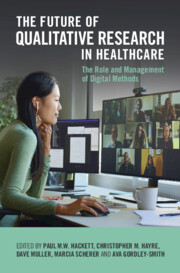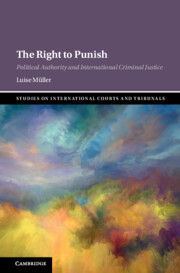3680 results

The Future of Qualitative Research in Healthcare
- The Role and Management of Digital Methods
- Coming soon
-
- Expected online publication date:
- August 2024
- Print publication:
- 31 August 2024
-
- Book
- Export citation

The Right to Punish
- Political Authority and International Criminal Justice
- Coming soon
-
- Expected online publication date:
- May 2024
- Print publication:
- 23 May 2024
-
- Book
- Export citation
New and improved bounds on the contextuality degree of multi-qubit configurations
-
- Journal:
- Mathematical Structures in Computer Science , First View
- Published online by Cambridge University Press:
- 18 April 2024, pp. 1-22
-
- Article
- Export citation
Campaign communication and legislative leadership
-
- Journal:
- Political Science Research and Methods , First View
- Published online by Cambridge University Press:
- 04 April 2024, pp. 1-22
-
- Article
-
- You have access
- Open access
- HTML
- Export citation
Paramagnetic Defect Centers in Hydrothermal Kaolinite from an Altered Tuff in the Nopal Uranium Deposit, Chihuahua, Mexico
-
- Journal:
- Clays and Clay Minerals / Volume 38 / Issue 6 / December 1990
- Published online by Cambridge University Press:
- 02 April 2024, pp. 600-608
-
- Article
- Export citation
Swelling Pressure Calculated from Mineralogical Properties of a Jurassic Opalinum Shale, Switzerland
-
- Journal:
- Clays and Clay Minerals / Volume 33 / Issue 6 / December 1985
- Published online by Cambridge University Press:
- 02 April 2024, pp. 501-509
-
- Article
- Export citation
Breathing Down My Neck: Nonfiction Gone Wrong
-
- Journal:
- TDR: The Drama Review / Volume 68 / Issue 1 / March 2024
- Published online by Cambridge University Press:
- 01 March 2024, p. 191
- Print publication:
- March 2024
-
- Article
- Export citation
Structural Fe3+ in Natural Kaolinites: New Insights from Electron Paramagnetic Resonance Spectra Fitting at X and Q-Band Frequencies
-
- Journal:
- Clays and Clay Minerals / Volume 47 / Issue 5 / October 1999
- Published online by Cambridge University Press:
- 28 February 2024, pp. 605-616
-
- Article
- Export citation
FTIR Reflectance vs. EPR Studies of Structural Iron in Kaolinites
-
- Journal:
- Clays and Clay Minerals / Volume 42 / Issue 3 / June 1994
- Published online by Cambridge University Press:
- 28 February 2024, pp. 308-320
-
- Article
- Export citation
Formation of Hydrotalcite-like Compounds During R7T7 Nuclear Waste Glass and Basaltic Glass Alteration
-
- Journal:
- Clays and Clay Minerals / Volume 42 / Issue 5 / October 1994
- Published online by Cambridge University Press:
- 28 February 2024, pp. 526-533
-
- Article
- Export citation
Spectroscopic Approach for Investigating the Status and Mobility of Ti in Kaolinitic Materials
-
- Journal:
- Clays and Clay Minerals / Volume 43 / Issue 5 / October 1995
- Published online by Cambridge University Press:
- 28 February 2024, pp. 615-621
-
- Article
- Export citation
Fe-Speciation in Kaolins: A Diffuse Reflectance Study
-
- Journal:
- Clays and Clay Minerals / Volume 42 / Issue 2 / April 1994
- Published online by Cambridge University Press:
- 28 February 2024, pp. 137-147
-
- Article
- Export citation
Nomenclature of the Micas
-
- Journal:
- Clays and Clay Minerals / Volume 46 / Issue 5 / October 1998
- Published online by Cambridge University Press:
- 28 February 2024, pp. 586-595
-
- Article
- Export citation
An Improved Model for Structural Transformations of Heat-Treated Aluminous Dioctahedral 2:1 Layer Silicates
-
- Journal:
- Clays and Clay Minerals / Volume 43 / Issue 6 / December 1995
- Published online by Cambridge University Press:
- 28 February 2024, pp. 718-731
-
- Article
- Export citation
Quantitative Measurement of Paramagnetic Fe3+ in Kaolinite
-
- Journal:
- Clays and Clay Minerals / Volume 48 / Issue 4 / August 2000
- Published online by Cambridge University Press:
- 28 February 2024, pp. 439-445
-
- Article
- Export citation
Nature and Stability of Radiation-Induced Defects in Natural Kaolinites: New Results and a Reappraisal of Published Works
-
- Journal:
- Clays and Clay Minerals / Volume 42 / Issue 6 / December 1994
- Published online by Cambridge University Press:
- 28 February 2024, pp. 657-666
-
- Article
- Export citation
Structural Transformation of 2:1 Dioctahedral Layer Silicates during Dehydroxylation-Rehydroxylation Reactions
-
- Journal:
- Clays and Clay Minerals / Volume 48 / Issue 5 / October 2000
- Published online by Cambridge University Press:
- 28 February 2024, pp. 572-585
-
- Article
- Export citation
Paramagnetic Fe3+: A Sensitive Probe for Disorder in Kaolinite
-
- Journal:
- Clays and Clay Minerals / Volume 45 / Issue 4 / August 1997
- Published online by Cambridge University Press:
- 28 February 2024, pp. 496-505
-
- Article
- Export citation
Trypillia mega-sites: a social levelling concept?
-
- Article
-
- You have access
- Open access
- HTML
- Export citation
Rediscovery of the waterlily Nymphaea thermarum Eb. Fisch. in Rwanda
-
- Journal:
- Oryx , First View
- Published online by Cambridge University Press:
- 21 February 2024, pp. 1-3
-
- Article
-
- You have access
- Open access
- HTML
- Export citation



